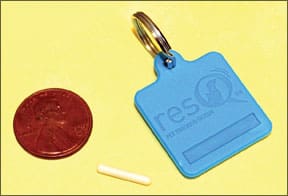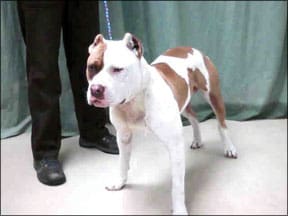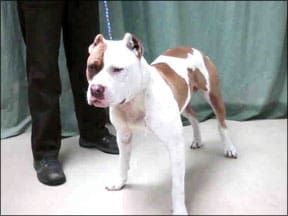Microchip Registration Locator Tools Launched
New databases aspire to make it easier to track down microchip registration
There are currently seven different pet identification microchip registries in the U.S., making it difficult to track down a found pets owner even when a scan finds a microchip number. Adding to the confusion, the chips manufacturer may not be the company that registered the chip. For example, I had a dog whose microchip was made by HomeAgain but registered with AKC Companion Animal Recovery (CAR). All the registries that exist in the U.S. will register their competitors chips as well as their own, but most charge a fee for doing so.
Two companies have emerged with Internet-based products that make it easier for rescuers to quickly locate the owner of a dog with an implanted identification microchip: the American Animal Hospital Association (AAHA) launched its PetMicrochipLookup.org, and Chloe Standard introduced ChecktheChip.com. Each built a website with a searchable database of microchip numbers, and attempts to return information about where a microchip is (or is most likely to be) registered.
288
The AAHAs Universal Pet Microchip Lookup Tool relies on collaboration with microchip manufacturers and distributors, and so far supports only four of the main registries: AKC CAR (Companion Animal Recovery), HomeAgain, PetLink, and resQ. Three other registries Banfield, AVID, and 24PetWatch are not currently supported, but AAHA hopes to expand its coverage in the future.
When you enter a microchip number into the AAHA Universal Pet Microchip Lookup Tool, it tells you where that microchip has been registered, the registration date (which may not be accurate at this time), the registrys phone number, and a link to the registrys website. If a microchip number is not found in any of the supported registries, it gives you contact information for the most likely manufacturer and registries including ones not supported by the database.
Chloe Standard, a private start-up company in Mountain View, California, launched its website, ChecktheChip.com, in August. The company hopes to finance its operation with advertising.
According to a representative for Chloe Standard, the company asked various microchip registries for lists of their database numbers (minus owner information), but, the company says, the registries have been slow to respond. This means that in many cases Chloe Standard can identify only the chips distributor. When you enter a microchip number that is recognized, you are given the name of the registry, its phone number, and a link to the companys website. In cases where a number is not recognized, ChecktheChip provides contact information for six registries: AKC CAR, HomeAgain, PetLink (which is misidentified on the site as ResQ), 24PetWatch, AVID, and Banfield.
To be certain that your dogs identification microchip is properly registered to you, and your contact information is current, enter his microchip number into both search tools. If the registration is found, you should check with the registries to confirm that the contact information they have is up to date. AAHA suggests that you contact the registry directly if your registration is not found in its database.
Our tests indicate . . .
I entered several identification microchip numbers in both ChecktheChip.com and PetMicrochipLookup.org, with mixed results.
When I entered the number of a microchip that was issued in 1995 and enrolled in two registries, AAHAs website correctly identified both registries. ChecktheChip.com did not recognize the chip number. When I entered an AVID microchip number that had never been registered, AAHAs site was able only to identify the chip as an AVID product and gave me AVIDs phone number. ChecktheChip returned AVIDs contact information, implying that the chip had been registered there a confusing result.
I tested four HomeAgain chip numbers, only one of which had been registered. AAHA correctly identified the registered chip and returned a phone number for that registry; for the other three chips, it gave me the contact information of three likely registries (HomeAgain, AKC CAR, and PetNet in Canada) and the chips manufacturer, Digital Angel. ChecktheChip returned only HomeAgains contact information for all four.
Both databases are still in an early stage of development, but as of this writing, AAHAs Universal Pet Microchip Lookup Tool appears to be the more useful.
Mary Straus
For more information:
AAHA Universal Pet Microchip Lookup Tool: PetMicrochipLookup.org
Chloe Standard
ChecktheChip.com
Variety Is Important for Nutritional Completeness
Renowned nutritionist deplores reliance on single-recipe diets
Marion Nestle is the award-winning author of Pet Food Politics: The Chihuahua in the Coal Mine, the story of the massive pet food recall in 2007, and the upcoming Feed Your Pet Right: The Authoritative Guide to Feeding Your Dog and Cat, due out in May 2010. A renowned professor of nutrition, food studies, and public health, Nestles interest in nutrition extends to both people and pets.
In her Pet Food Politics blog, Nestle recently wrote about the limitations of nutrition analyses and databases as aids for creating healthy diets for people. I was surprised by how closely her words echoed my own feelings in relation to the drawbacks of relying on a single recipe developed with a spreadsheet to feed a dog.
Referring to the databases used to create these recipes, Nestle says, If you give it even a moments thought, you realize that the nutrient contents have to vary with growing location, soil conditions, climate, transportation, and storage, so the amounts given in the database can only be approximations of what you are actually eating [our emphasis]. The data arent meaningless, but they dont mean nearly as much as people think they do.
Exactly. Too many recipes created with spreadsheets, including those from veterinary nutritionists, provide only minimal amounts of important nutrients. If the foods used to create these recipes dont match up to the numbers in the database, the recipes are likely to be lacking in some areas. Feeding the same recipe and nothing else for long periods of time may lead to nutritional deficiencies.
The same problem can occur when you feed one commercial food exclusively. Foods that state they are formulated to contain complete and balanced nutrition for dogs may not actually do so for a number of reasons. These include how the food is stored; changes in the ingredient sources; and whether laboratory analysis of the food itself was conducted to confirm its nutrient content (as opposed to tests of a similar food from its maker, or a feeding trial to determine its nutritional adequacy).
I recommend choosing at least two or three different brands, using different protein sources, and rotating among them. If one food is deficient in some areas, the odds are that the next food will make up for it, especially if its made by a different company though that food may be deficient in other areas.
Spreadsheets have their place, especially when you need to control specific nutrients due to health problems. A spreadsheet can help you determine how to limit phosphorus in diets for dogs with kidney disease, for example. Even then, its safer to use multiple recipes that include different ingredients rather than always feeding the same recipe.
Nestle goes on to say, We know from studies using experimental animals that it is extremely difficult to induce nutrient deficiencies in animals that are fed a variety of foods providing sufficient calories. The best way to avoid nutrient deficiencies is to eat a variety of minimally processed foods. If you do that, you dont have to worry about specific nutrients.
Rather than relying on a single recipe created with a spreadsheet to ensure that your dogs nutritional needs are met, feed a wide variety of fresh foods in appropriate proportions; thats the best way to create a healthy diet for your dog, as well as for your family. Mary Straus
For more information:
foodpolitics.com, by Marion Nestle
New Pennsylvania Law Bans Five Home Surgeries
Law targets puppy mill operators and dog fighters; vets may still perform procedures
Late August headlines that blared about Governor Ed Rendell signing a bill banning ear-cropping, debarking, tail-docking, performing C-sections, and removing dewclaws were a little misleading, as the new law only applies to surgeries that are performed by non-veterinarians.
Rendell was quoted as saying, House Bill 39, which clearly defines the painful and inhumane procedures on dogs that constitute animal cruelty, takes the next important step for Pennsylvania in protecting dogs, said Rendell. Until now, these cruel practices could be carried out by dog owners without proper training and without supervision by a licensed vet, which could lead to long-term injury, pain and, in some cases, death to these defenseless animals.
Photo courtesy HCPHES 288
An owner who has these surgeries performed legally must now keep a record of the surgery, including the vet who performed it, as well as the location and date where the surgery was performed. Any person in possession of a dog upon whom any of the listed surgeries have been performed is in violation of the new law (not just the person who performed the surgery) unless they have a certificate from the veterinarian who performed the procedure, or a certificate from their county treasurer (at a cost of $1) showing that the procedure was done before the law became effective. Violation of the law is a summary offense, punishable by a fine of up to $300 and/or 90 days (maximum) in jail.
The new law further protects dogs by making it a third degree felony to steal or acquire in any manner an animal for the purpose of fighting. Pat Miller






